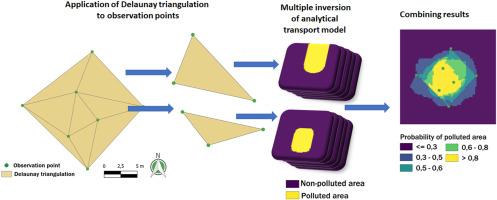通过逆分析模型优化土壤修复量
IF 4.6
2区 环境科学与生态学
Q1 COMPUTER SCIENCE, INTERDISCIPLINARY APPLICATIONS
引用次数: 0
摘要
表征土壤和地下水污染是一项重大的环境挑战。这项工作的目的是为受污染影响的土壤总量制定一种更好的估计方法。该方法采用基于非饱和区流动和输运解析解的逆建模方法。该模型依次应用于通过Delaunay三角剖分定义的点的三胞胎。结合反演结果,重构了污染物在地下的空间非均质分布。该方法通过一个异质综合案例进行了评估,该案例具有待估计点浓度数据的不同规则和随机空间分布。根据观测点分布的不同,该方法与其他空间插值方法相比,绝对误差降低了40 - 70%。该方法对于点数减少(小于10)特别有用。本文章由计算机程序翻译,如有差异,请以英文原文为准。

Optimizing soil remediation volumes via inverse analytical modeling
Characterizing soil and groundwater pollution is a major environmental challenge. The aim of this work was to develop a better estimation methodology for the total volume of soil impacted by pollution. The proposed methodology employs an inverse modeling approach based on an analytical solution of flow and transport in the unsaturated zone. The model was applied sequentially to triplets of points defined via Delaunay triangulation. By combining the inversion results, a spatially heterogeneous distribution of contaminants in the subsurface was reconstructed.
This approach was evaluated via a heterogeneous synthetic case with different regular and random spatial distributions of the point concentration data to be estimated. Depending on the distribution of observation points, the method developed provides a 40–70 % reduction in the absolute error compared with that of the various spatial interpolation methods. The method is particularly useful for a reduced number of points (less than 10).
求助全文
通过发布文献求助,成功后即可免费获取论文全文。
去求助
来源期刊

Environmental Modelling & Software
工程技术-工程:环境
CiteScore
9.30
自引率
8.20%
发文量
241
审稿时长
60 days
期刊介绍:
Environmental Modelling & Software publishes contributions, in the form of research articles, reviews and short communications, on recent advances in environmental modelling and/or software. The aim is to improve our capacity to represent, understand, predict or manage the behaviour of environmental systems at all practical scales, and to communicate those improvements to a wide scientific and professional audience.
 求助内容:
求助内容: 应助结果提醒方式:
应助结果提醒方式:


